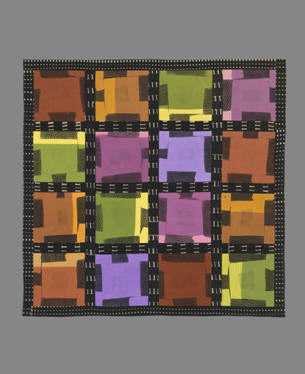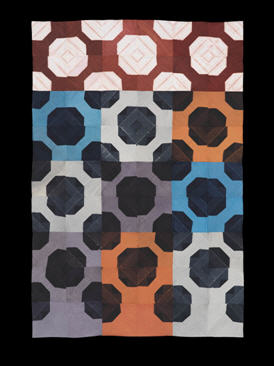Ana Lisa’s Horizontal Shift (2010) is a compelling synthesis of arashi shibori and Amish quilt geometry. It is a striking image and yet fluid at the same time, showcasing a delicate design in a bold framework. I thought it very appropriate that she was exhibited near Yoshiko Wada, since Ana Lisa was one of Yoshiko’s original shibori students. Since the 1960’s, Ana Lisa has been a textile artist that has not stood still! She is adept at and recognized for innovation, successfully incorporating new technology with practiced art. Her work is in the permanent collections of many reputable museums – including the de Young – and she has been the recipient of numerous prestigious awards, twice receiving the Craftsman’s Fellowship from the National Endowment for the Arts.

"Bowtie" By Ana Lisa Hedstrom
As a student in Yoshiko Wada’s 1975 shibori class, Ana Lisa discovered that she loved shibori and continued working in that medium, concentrating in arashi. At that time, the Japanese arashi technique was executed on wood poles the size of telephone poles! Experimentation with bottles, mono tubes and the ultimate discovery of PVC pipes produced an interesting journey in the development of each artist’s technique.
During my conversation with Ana Lisa, we discussed her use of the arashi technique and her inspirations.
CC: Were you surprised to be part of this exhibition?
ALH: I am thrilled to be a part of it. There are so many rare pieces on display. Dyeing, and especially shibori, can be very simple, logical, and easy, but it can also be very complex. It can also require a wide breadth of skill.
CC: The Amish are known for considering beauty as an art of function, and traditionally only used solid colors to create their quilt designs which emphasized their complex stitching. How were you inspired to combine shibori in the Amish quilt format? In Horizontal Shift, is your dialogue with color and structure speaking to the commonalities of these two strong traditions, or building a bridge to a new application of technique?
ALH: I consider Amish one of the premier art forms. Most recently I have discovered the Ohio western region of Amish quilt design, particularly the Bow Tie pattern. One of my techniques involves folding and wrapping, resulting in patterns that resemble the Bow-Tie piecing. Working with these dyed squares I play with scale, color, and arrangement.
My piece in the de Young exhibit is more abstract, working with stripes and rearranging them. There isn’t a direct connection in referencing Amish or traditional quilts, which you can see more distinctly in some of my other work, such as Circle Bow Tie. My Bow Tie quilts are done as an homage to the Amish – they are a specific reference to that art form, but in my own interpretation.

"Circle Bowtie" By Ana Lisa Hedstrom
I think of my art form as collage, because of the piecing. Shibori was originally a dye application for Kimono where a graphic design was part of the stitching or wrapping. I work with color, scale, positive and negative space – all the aspects of basic design. My fabrics are dyed first and then I cut and mix them up. This is my artistic statement.
CC: What is your most reliable muse for inspiration?
ALH: All quilt types – but more than that, I love textiles. But I noticed that if I reference textiles too closely, or if I look at them too much I get saturated and they aren’t useful as inspiration – it just becomes more of the same thing. Each work is speaking to you on its own, so in some ways it’s all been done. I get more inspired by looking outside of my own field. I love where a tradition changes and people feel free to stretch it. You experiment and play in the studio and find a result accidentally that you want to follow, and then it’s yours.
It’s important for the craftsman to follow a route of discovery – from color choice, to how it’s being dyed, to how it’s going to be arranged. It’s so extraordinary that something so simple can be made in so many different ways. I follow my hand in the studio. I love to look at contemporary art – stepping out of my own field and getting inspired by creative people. A good example is my Square Dance quilt. It’s an older piece, and has a musical reference as part of my musical mode series based on American forms of music and dance. I love blue grass, the blues, and jazz. This music and the American patchwork quilt tradition are indigenous arts – they both have a structure but room for improvisation, making it both traditional and unique.
CC: Some of your pieces contain geometric shapes which add to but do not detract from the fluid movement of the piece. How do you achieve that sense of balance in your work?
ALH: With my piecing work, I think it’s because the stripes are not rigid or parallel – they are uneven, which is done on purpose. I have made studio art quilts which have little piecing, but piecing is my main love. I also like the surface of hand stitched quilts, but find I don’t always have the time to incorporate that technique in all my designs.
You can see more of Ana Lisa’s work at http://shiboriorg.wordpress.com/members/analisahedstrom/ http://shiboriorg.files.wordpress.com/2009/02/hedstrom_21.jpg
Go to Yoshiko